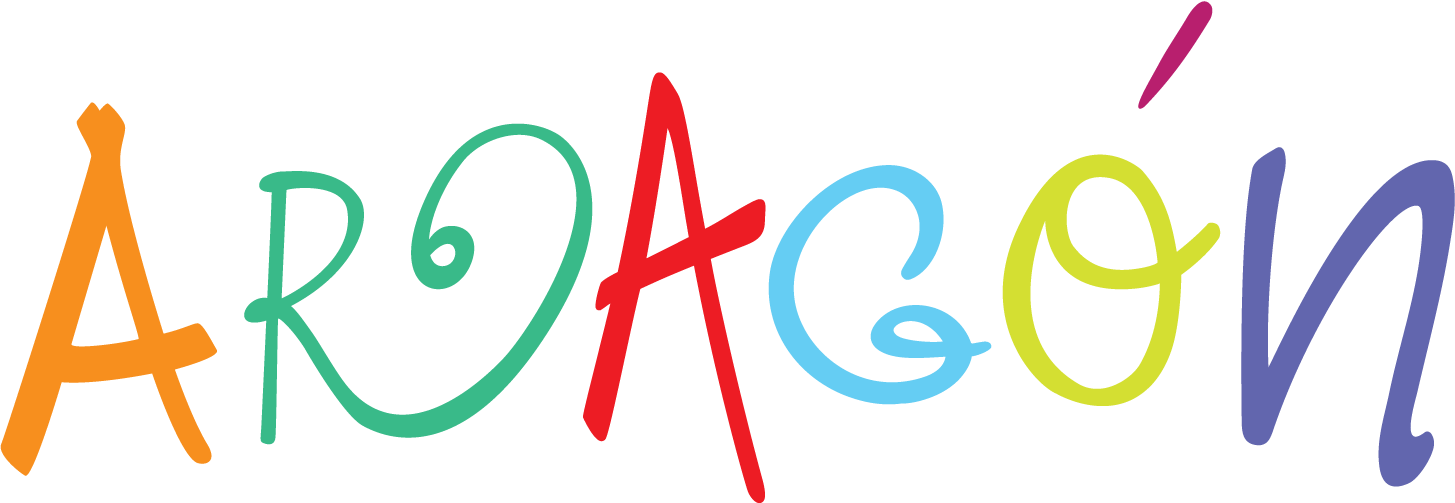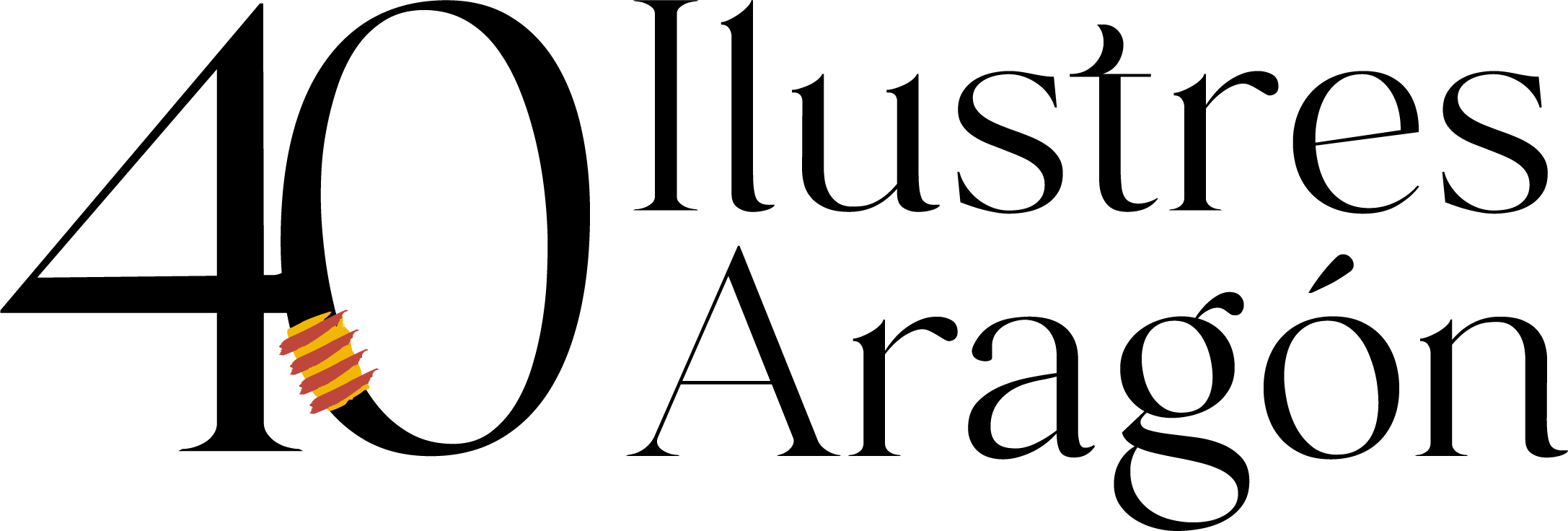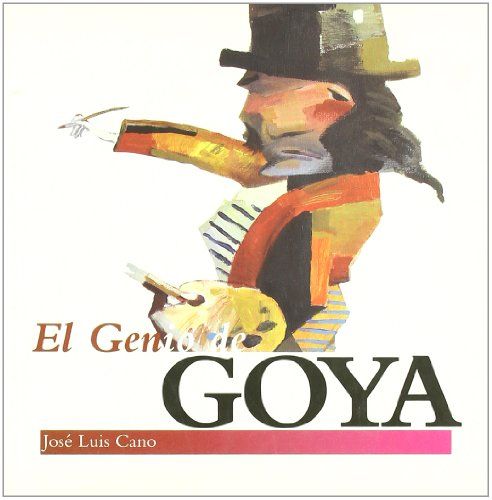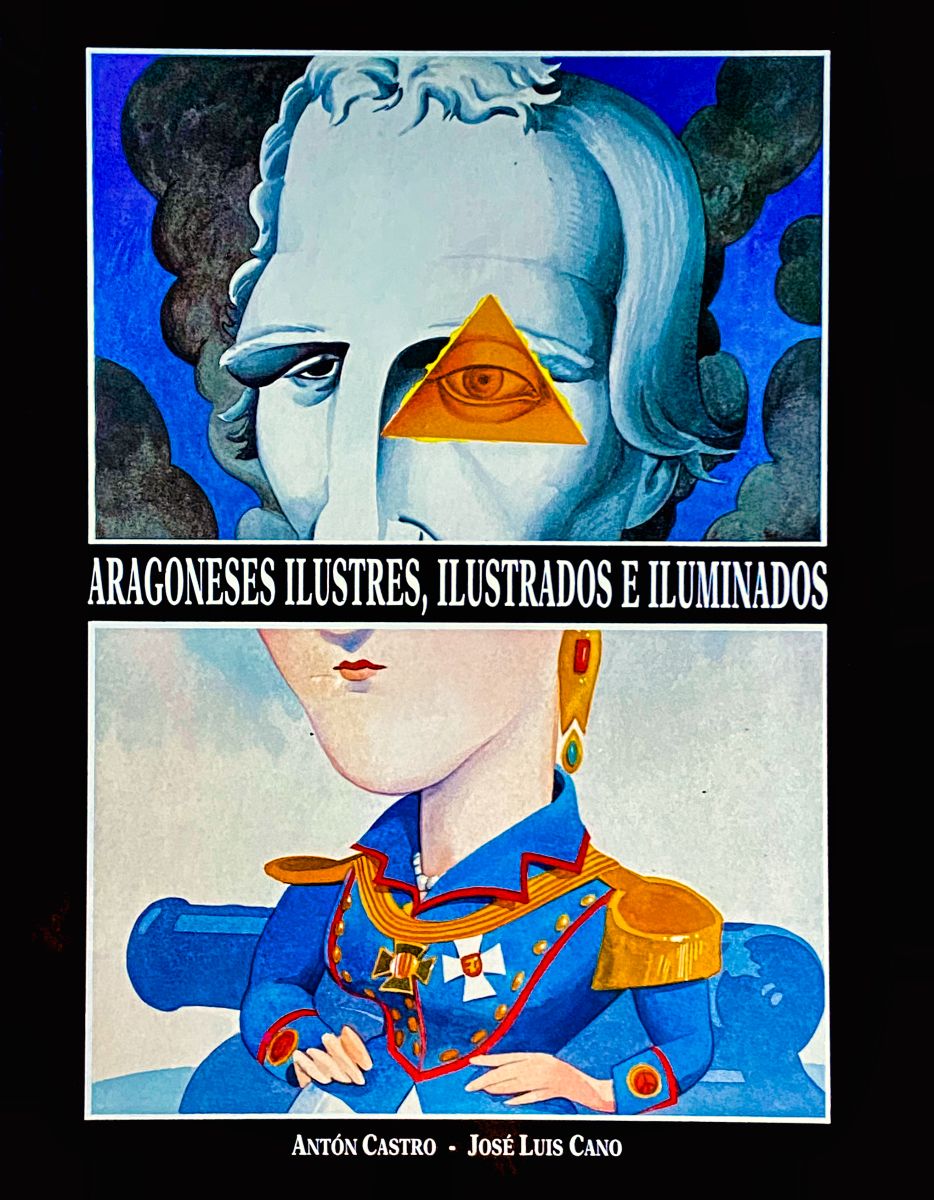Francisco de Goya
the painter of souls
Fuendetodos, 1746 – Burdeos, 1828
In the mid-18th century, one of the most famous painters of all time was born in a small village in Aragon. His popularity is now universal. He is known in every corner of the world, from Alaska to Australia and from Chile to Japan.
He is considered to be the first “modern painter”, not only in his choice of subjects but also in the way he approached them, with a new artistic language. His works guided most of the aesthetic movements of the 19th and 20th centuries:
Romanticism, Impressionism, Expressionism, Symbolism, Surrealism… And he is probably one of the artists of the past who most influences today’s creators.
Although he was at the service of the powerful and heeded their requests, in his most intimate compositions he revealed the abuses, ignorance, fanaticism and moral degradation that they nurtured. He brought before the eyes of the spectators scenes of unparalleled beauty but also the most terrible and hidden aspects of the human soul.
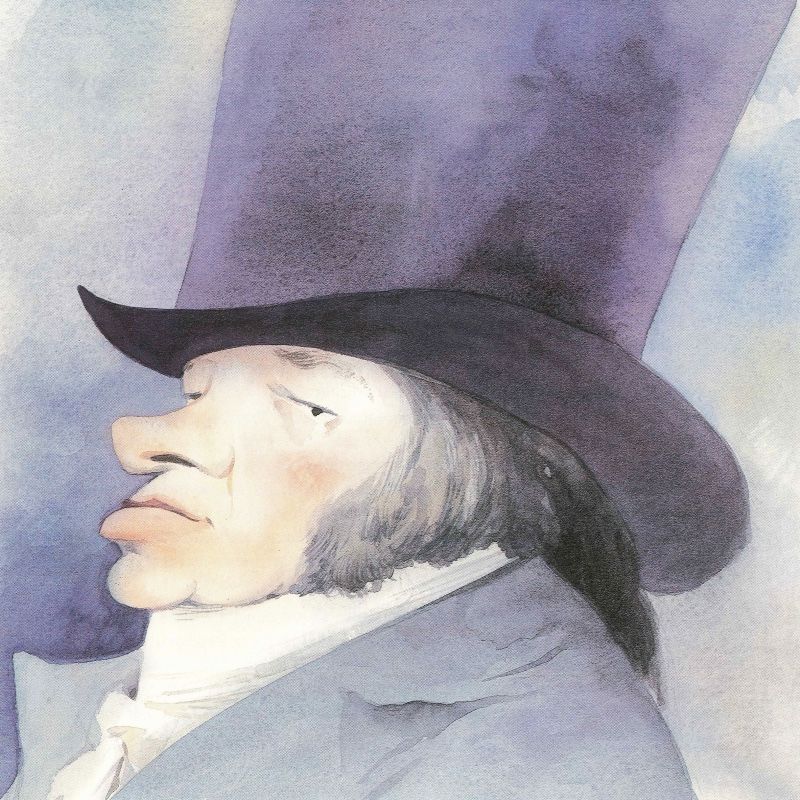
Life
This painter, Francisco de Goya, was born in 1746 in Fuendetodos, a few kilometres from Saragossa, the city where he spent his entire childhood and youth. In the Aragonese capital he was a pupil at a prestigious art school run by the Saragossan José Luzán. He then entered several competitions organised in Madrid in order to continue his training at the San Fernando Royal Academy of Fine Arts, although without success. His exercises were not to his liking and the places at stake were won by others. He then decided to go to Italy to continue learning. He spent two years in Rome, where he learned about what the masters of the past had done and what the most outstanding artists of his time were doing.
After his return to Saragossa, he married and obtained important commissions, especially monumental paintings on walls, in which he was able to display all he had learnt. He decorated a vault in the Basilica of El Pilar, the choir, with angels adoring God, and later recreated various passages from the life of the Virgin in the Carthusian monastery of Aula Dei. He soon became one of the most highly esteemed painters in Aragon. However, in 1775 he decided to move to Madrid in order to succeed at court with the help of Francisco Bayeu, his wife’s brother.
Work
He began by painting cartoons with scenes depicting popular characters, which served as models for the tapestries used to decorate the royal palaces. He returned to Saragossa to fresco a dome of the Pilar, but his work was not appreciated and he returned to Madrid. There, little by little, his prestige increased and he obtained increasingly important posts in the service of the king. He painted pictures of religious subjects and, in an attempt to capture their personality, portrayed the monarchs, some of their ministers, members of the nobility, members of the military, wealthy merchants and renowned intellectuals associated with the ideas of the Enlightenment, which he shared and which aimed to modernise the country and bring it out of its economic and intellectual backwardness.
At the same time, he began to produce his own engravings, which were easy to reproduce and disseminate. In 1799 he put on sale a series of his own invention, the Caprichos, in which he satirically criticised the evils of Spanish society. He denounced vices and harmful customs, as well as incompetent professionals (doctors, teachers…) and harmful characters (decadent nobles, fanatical priests…). And it included witches and monstrous beings, typical of the night, opposed to what the light of reason represented.
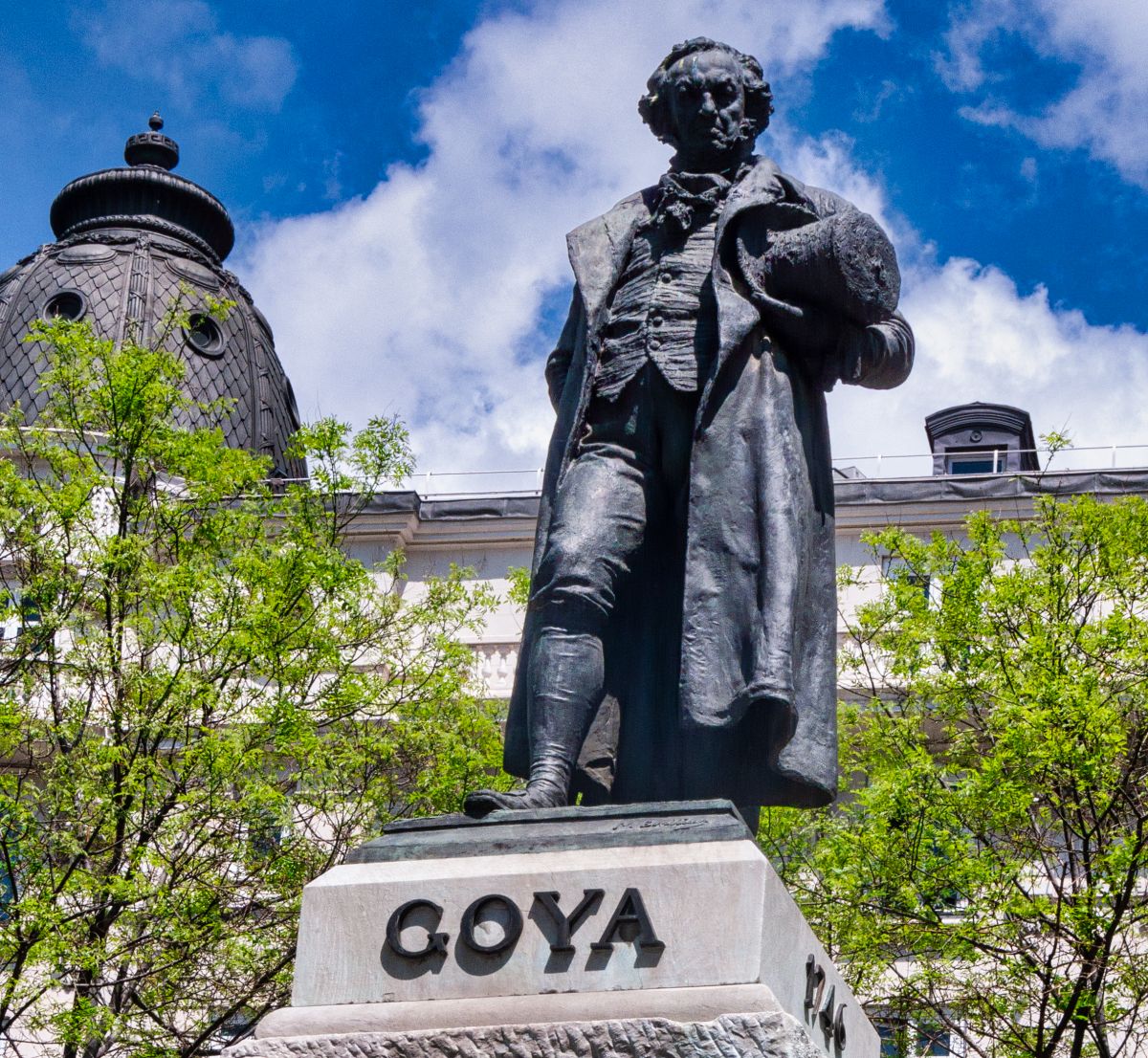
His engravings
First the French Revolution and then the Napoleonic invasion and the War of Independence completely disrupted the lives of Spaniards, including Goya’s. Violence and death were unleashed. The Aragonese painter reflected what was happening in a chilling series of engravings, The Disasters of War, and in two large paintings, The Charge of the Mamelukes and The Shootings on the Mountain of Príncipe Pío, which bore witness to cruel and senseless slaughter. Contrary to what had hitherto been seen in history paintings, Goya’s works are not theatrical heroes in shining uniforms or ideal behaviour to admire, but the reality of war: filth, brutality, madness, suffering, terror.
Without abandoning his personal obsessions and way of thinking, Goya worked on two other series of prints, the Tauromaquia and the Disparates, with increasingly advanced techniques. He continued to capture the madness of the world with his brushes, painting portraits and taking on official commissions. But after the war, however, the country was divided into two opposing camps, one in favour of progress, of which the painter was a member, and the other clinging to traditional ways of acting. Goya gradually isolated himself and sought refuge in an estate on the outskirts of Madrid, the Quinta del Sordo, on whose walls, away from public view, he depicted a series of grotesque, ghostly characters reflecting his tormented state of mind, the so-called “Pinturas negras” (“Black Paintings”).
When the repression by the absolutists led by King Fernando VII increased and many of his friends were executed, arrested or exiled, he decided to settle in Bordeaux, where he spent the last years of his life. In that French city, despite his advanced age, he still had the strength to experiment with technical and compositional innovations, both in paintings such as The Milkmaid of Bordeaux, with its Pre-Impressionist features, and in works to be reproduced on paper, such as the series of lithographs entitled The Bulls of Bordeaux.
References
- Arturo Ansón (1995): Goya y Aragón. Zaragoza, Caja de Ahorros de la Inmaculada, col. Mariano de Pano.
- José Luis Cano (2004): El genio de Goya. Zaragoza, Xordica.
- José Camón Aznar (1980-1982): Francisco de Goya (4 vols.). Zaragoza: Ibercaja.
- Antón Castro (1993): “Añoranza de don Francisco de Goya”, on Aragoneses ilustres, ilustrados e iluminados (132-137). Zaragoza: Gobierno de Aragón.
- Laurent Matheron (1996): Goya (ed. facsímil). Zaragoza: DGA.
- AA. (2001):Goya. Barcelona: Galaxia Gutenberg – Círculo de Lectores.
- AA. (2009): Goya: Museo de Zaragoza. Exposición permanente. Zaragoza: Gobierno de Aragón.
- Fundación Goya en Aragón: https://fundaciongoyaenaragon.es/
- Gran Enciclopedia Aragonesa on line: http://www.enciclopedia-aragonesa.com/monograficos/biografias/goya/default.asp
Teaching activities
Goya in Aragón
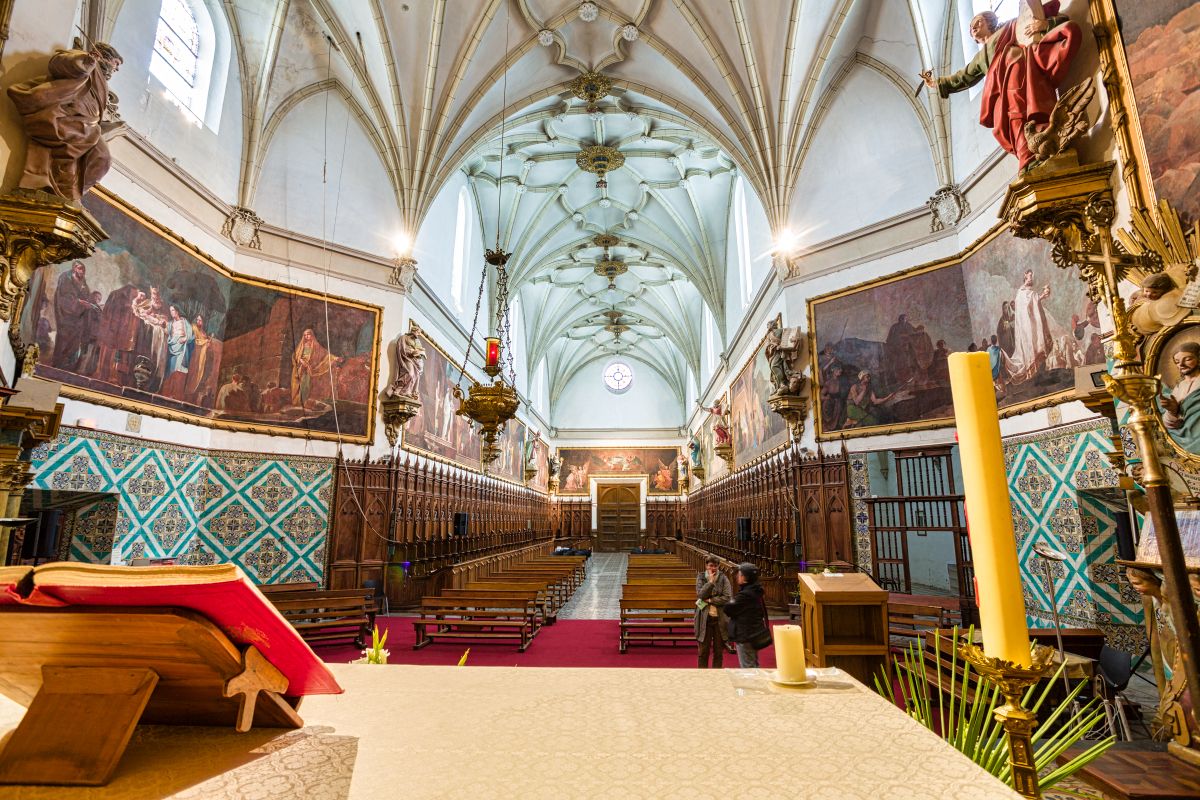
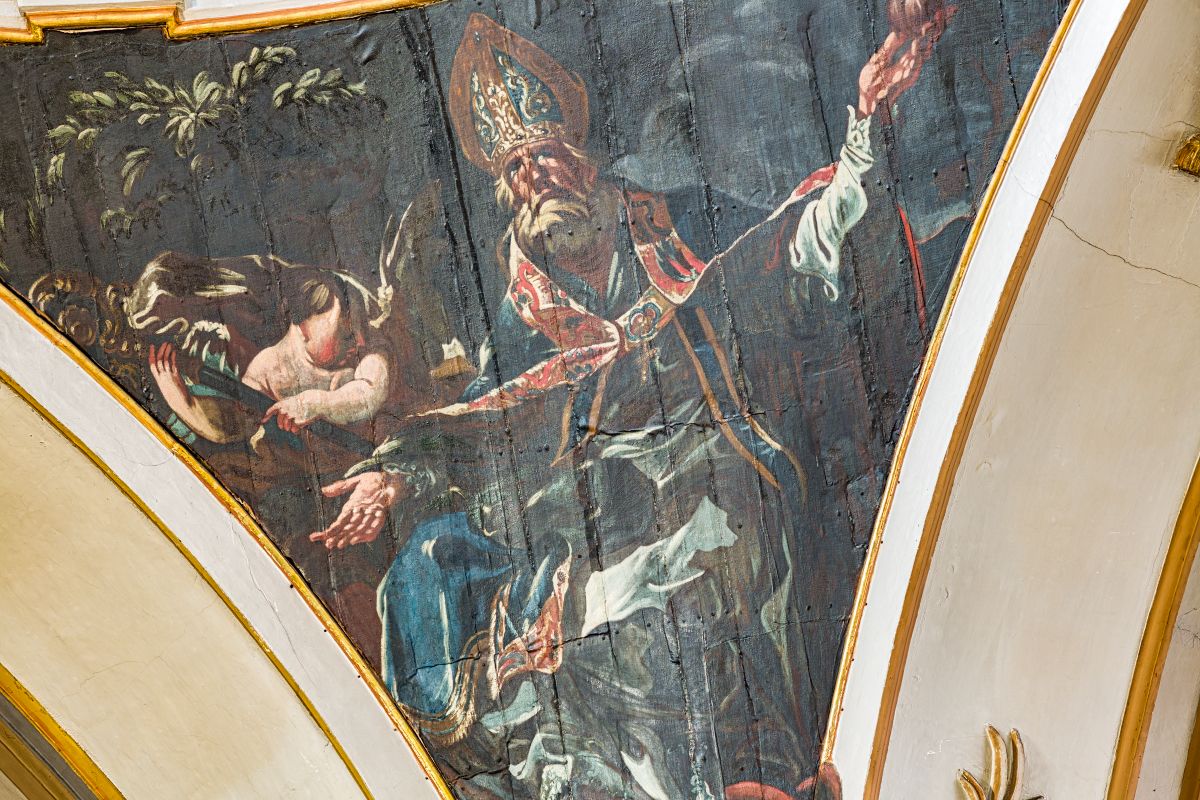
His father, a gilder by trade, had for his only fortune two sun-drenched houses [in Fuendetodos]. The good man did not concern himself much with his son’s education and let him live in the open air and wander in the immediate mountains, as if he wanted to make a sturdy peasant of him. Francisco was at fifteen years of age a boy of fine countenance and of a vigour and agility that could challenge a deer in the race. […]
One day, while carrying a sack of wheat to the next mill, he stopped in the middle of the road and, humming a song, began to draw a pig on a wall with charcoal.
His lucky star led him to an old friar from Saragossa who knew how to know men and measure them at a glance.
The monk stopped and, after staring at the boy, whose hand was running and drawing on the wall, touched him on the back and asked him who his master was.
-I don’t have one, reverend, nor do I need one,” answered Francisco.
-If you want to come with me to Saragossa,” the newcomer proposed, “I will give you a master and you will be a great painter.
-To Saragossa! I very much wish to go, if my father consents,” he replied.
Goya’s father agreed to believe what the friar told him, and the boy Francisco was transported to Saragossa.
This is how the Frenchman Laurent Matheron, Francisco de Goya’s first biographer, described the atmosphere in which he spent his early years and the fortuitous discovery of his artistic talent. Nothing to do with reality. Goya was born in the small village of Fuendetodos, but when he was only a month old his parents took him to Saragossa, where all his older brothers and sisters had been born and where his younger brothers and sisters were also born. He spent all his childhood and youth in the Aragonese capital. Here he went to school and later to the art school run by another painter, José Luzán. It was also in Aragon that he began his professional career. He was already a highly appreciated painter when he left for Madrid, after his marriage, to get better work.
In his native Aragon one can see works from the first stage of his life, but also from later stages.
Do you know where the following works by Goya are located in Aragon? Match the works in the left column with the locations on the right.
1. Portrait of Felix de Azara a) Saragossa Museum
2. Regina Martyrum b) Basilica of El Pilar
3. Los desposorios de la Virgen c) Goya Museum
4. Portrait of Fernando VII d) Cartuja de Aula Dei
5. La adoración del nombre de Dios e) Goya Museum
6. Los disparates f) Basilica of El Pilar
Solution: 1-c; 2-b; 3-d; 4-a; 5-f; 6-e
In which of the following Aragonese towns can you not see any work attributed to Goya?
Alagón; Calatayud; Saragossa; Quinto de Ebro; Muel; Remolinos.
Solution: Quinto de Ebro
Goya practised various painting techniques. He painted in fresco on walls, oil paintings on canvas or on walls and made numerous engravings. Examples of all of them are preserved in Aragon.
Do you know what the fresco technique is and why it is called that? And what are the different types of engraving? Look up information on the internet about both artistic techniques.
Match the works in the left column with the technique used in the right column.
1. Autorretrato a) Engraving
2. Regina Martyrum b)Fresco on wall
3. El nacimiento de la Virgen c) Oil on canvas
4. Los desastres de la guerra d) Oil on wall
5. Retrato de Luis de Borbón y Vallabriga niño e) Engraving
6. La tauromaquia f) Oil on canvas
Solution: 1-c; 2-b; 3-d; 4-a; 5-f; 6-e
Velázquez and Goya
When speaking of other painters who had influenced his way of painting, Goya only mentioned Rembrandt and Velázquez. He particularly admired Rembrandt’s engravings, as there was only one painting by him in Spain. Of Velázquez, he studied in depth the canvases that were kept in the collections of the kings of Spain, and some of them he even reproduced in small oil paintings and engravings.
Do you know who these painters were and what period they lived in?
Search the internet for images of Las Meninas by Velázquez and two works by Goya that also depict groups of people: The Family of the Infante Luis de Borbón and The Family of Carlos IV. What similarities do you see between Velázquez’s work and Goya’s? And what differences?
Tapestry cardboard and black paints
When Goya arrived in Madrid, the first commission he received was to paint cartoons with images that would serve as models for tapestries to decorate the royal palaces. The painter could not choose the theme to be depicted. They had to be scenes related to hunting, fishing or popular pastimes and festivals, as these were the ones the monarchs liked best. And they had to have a simple composition and colouring so that the weavers could reproduce them with threads on their looms without difficulty. Despite these conditions, Goya was able to devise compositions that are now famous all over the world.
Search the internet for images of Goya’s tapestry cartoons Which of the following titles does not correspond to a tapestry cartoon painted by the Aragonese painter?
El quitasol, La gallina ciega, La cometa, El columpio, El pescador de caña, La caza del jabalí, La granizada, La vendimia, El pelele.
Solution: La granizada
After the War of Independence and at the age of over seventy, Goya took refuge on the outskirts of Madrid in a country estate called La Quinta del Sordo and painted on its walls a series of scenes known as Pinturas negras (“Black Paintings”), very different from those he had devised decades earlier in his tapestry cartoons. While the latter were dominated by the joyfulness of the protagonists and the bright, luminous colours, in his country estate he depicted dark, sinister themes in a nocturnal and unreal setting, with disturbing caricatured characters with unhinged faces. After a long life in which Goya lived through serious illnesses, deafness, a terrible war and cruel political persecutions, as well as the death of almost all his children and his wife, old age and death are very present in these paintings.
Among the titles that have been given to the different black paintings are Duelo a garrotazos, Saturno devorando a un hijo, El aquelarre, La romería de San Isidro y Perro semihundido. Look them up on the internet and comment on a couple of them: what is depicted, with what characteristics? Compare one of the ones you have chosen with a tapestry card and highlight the differences you find.
Los caprichos
Goya is considered today to be one of the most important engravers in the history of art. Possessing boundless curiosity, over time he perfected the techniques he used and until the time of his death he experimented with new ones. In 1799 he released a series of engravings entitled Los Caprichos (The Caprices). In it he ridiculed bad habits, vices, ignorance, harmful powerful people and incompetent professionals, just as some literary figures of the time (Father Feijoo, José Cadalso, Jovellanos, Nicolás Fernández de Moratín, etc.) did in their works. And he added a gallery of witches and nightmarish beings, typical of the night, as the incarnation of everything opposed to what the light of reason meant.
In these prints, in order to parody social reality and denounce pernicious behaviour, Goya sometimes used animals for moralising purposes, as did the fabulists of his time Tomás de Iriarte and Félix María Samaniego.
If you can, visit the Goya Museum in Saragossa and look in the engraving room for some Caprichos featuring animals. If not, look them up on the Internet. Pay particular attention to No. 37, Sabrá más el discípulo; No. 40, De qué mal morirá; and No. 41, Ni más ni menos. Who is Goya criticising with them?
Locate and read one of Iriarte’s or Samaniego’s fables and what conclusion do you draw from it?
The use of animals as the protagonists of stories and legends is as old as man himself. Do you know that in Antiquity this type of tale was already common? Look up information about the most famous author of fables, the Greek Aesop.
Do you know other non-Spanish fabulists, such as La Fontaine? Do some research on him.
War and art
Jacques-Louis David was a French painter who lived at the same time as Goya. He was very famous during his lifetime and later became one of the most famous painters in history. Like Goya, he was the author of popular paintings depicting war scenes. However, the differences between the two are enormous, for while the Frenchman illustrates ideal scenes, the Aragonese painter depicts real scenes of brutality and death, as he also did in the series of engravings entitled The Disasters of War.
Look carefully at the first two paintings by David and the next two by Goya. Then answer the questions at the end.
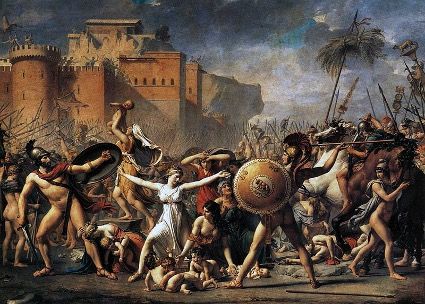
El rapto de las sabinas
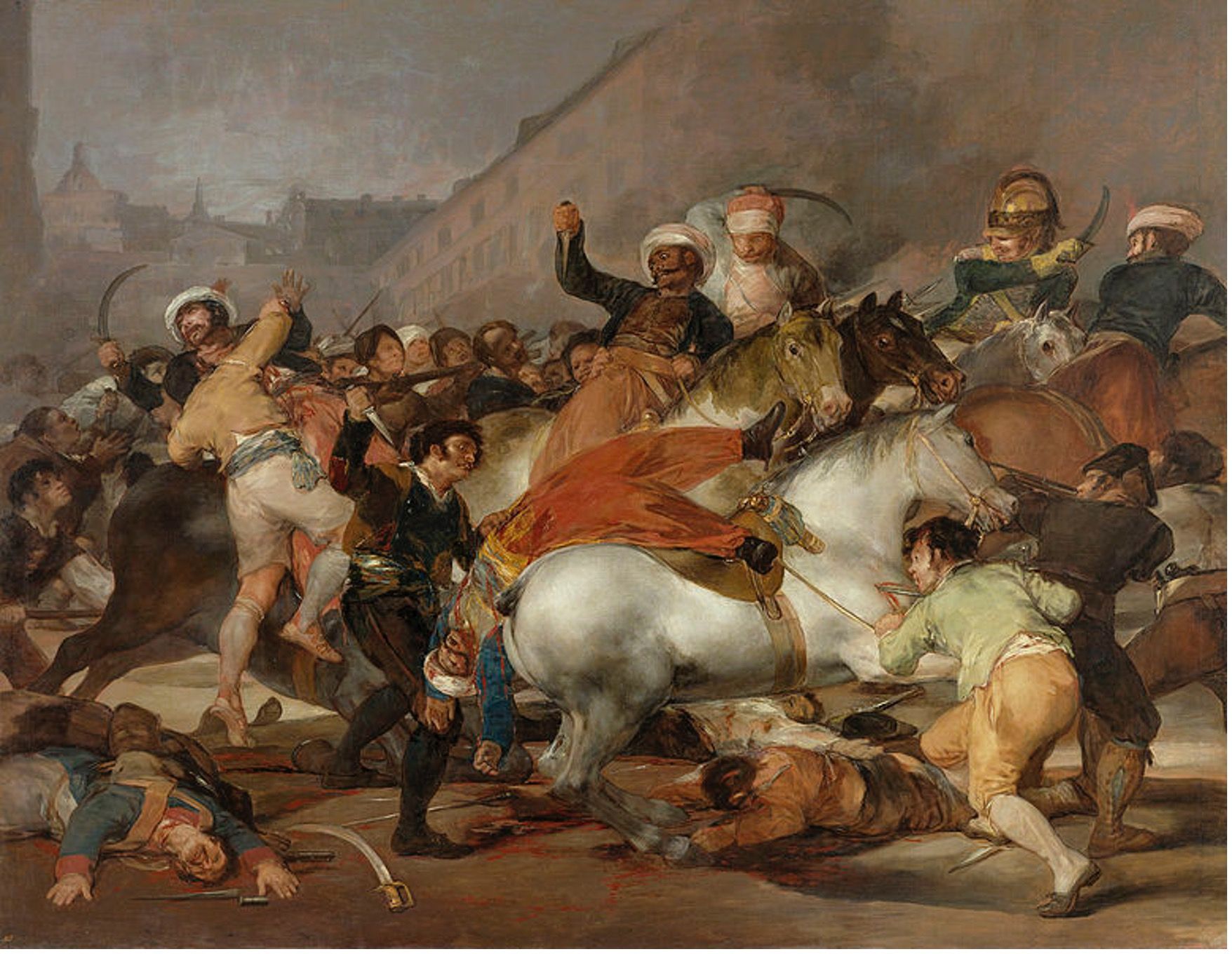
El dos de mayo de 1808 en Madrid o La carga de los mamelucos
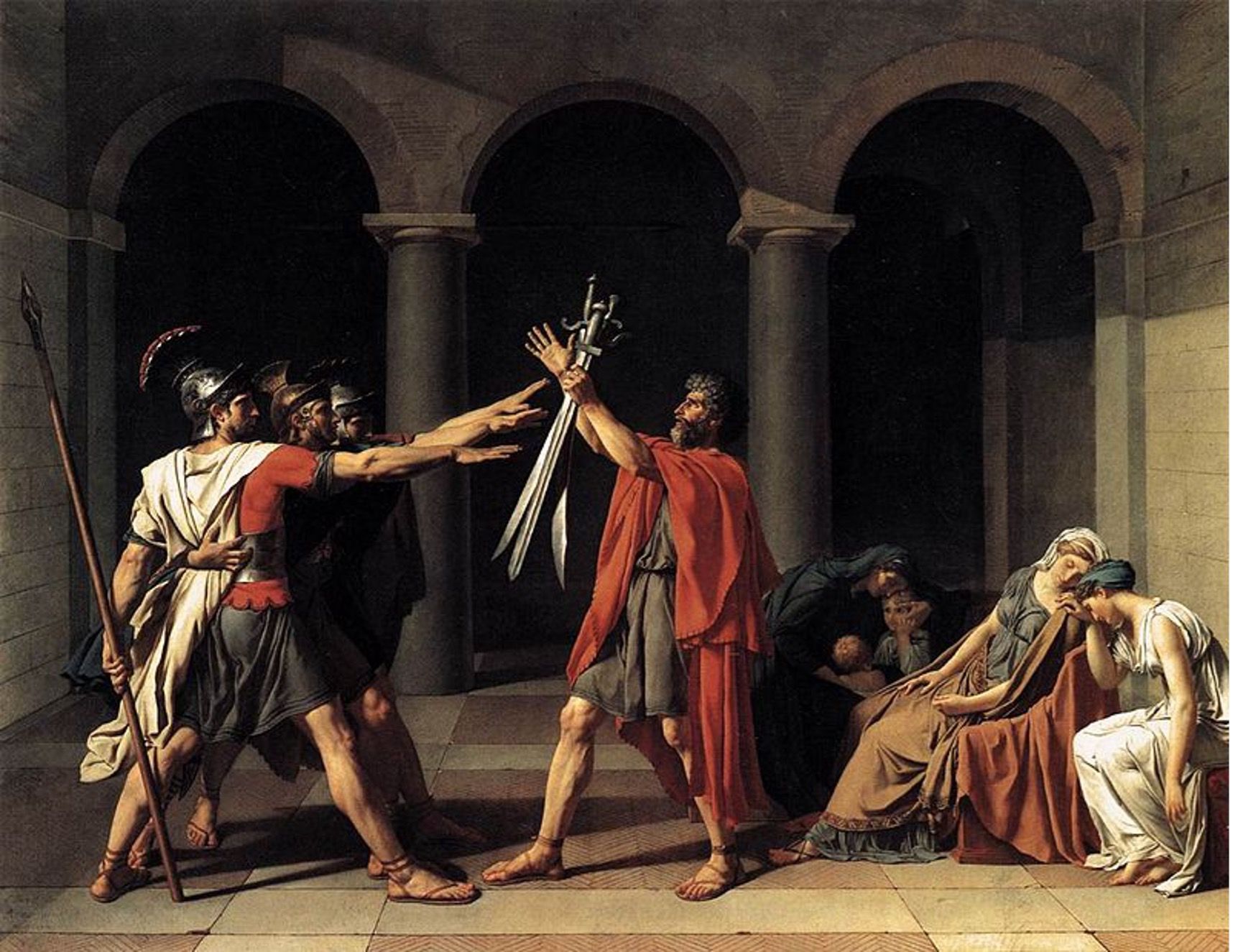
El juramento de los Horacios
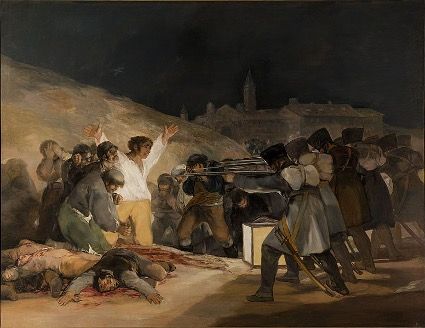
El tres de mayo de 1808 en Madrid o Los fusilamientos en la montaña del Príncipe Pío
What period do you think David’s paintings are set in, and Goya’s? What war did Goya experience and what repercussions did it have in Spain?
While David’s protagonists look serene, with clean clothes, in attitudes reminiscent of statues or a play, how do Goya’s protagonists look? Do they look like brave heroes? Are they famous or anonymous characters? Which painter do you think best describes war as it is?
Which painter denounces the horror and violence of war and which uses it to highlight exemplary attitudes? Does either emphasise the injustice of the weak against the strong? Who identifies war with reason and who with irrationality? Which of the two artists can be considered a witness of his time?
Who uses balanced compositions, precise drawing and restrained emotions? Who expresses rage, despair and fear with loose, passionate brushstrokes? Who uses uniform light and who uses sharp contrast of light and shade to heighten the drama?
El genio de Goya
Download from this link the PDF of the publication edited by the Xordica publishing house with the sponsorship of the Obra Social de Ibercaja.
Aragoneses ilustres, ilustrados e iluminados
Download from this link the PDF of the publication Aragoneses ilustres, ilustrados e iluminados, by Antón Castro and José Luis Cano, published by the Government of Aragón in 1993.

DIRECCIÓN GENERAL DE POLÍTICA LINGÜÍSTICA
Departamento de Educación, Cultura y Deporte
Parque Empresarial Dinamiza (Recinto Expo)
Avenida de Ranillas, 5D - 2ª planta
50018 Zaragoza
Tfno: 976 71 54 65
Colabora:

